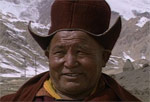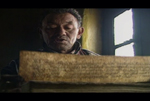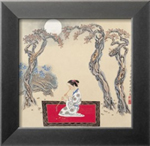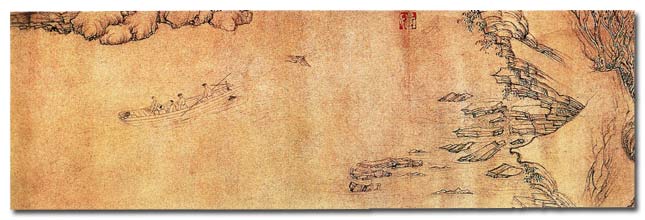The Tibetan Book of the Dead
„The Tibetan Book of the Dead is the guide for the dying. It describes the process of dying as the natural transition. The text explains how, by recognizing the mental states and physical sufferings involved, we can come in contact with our own essential nature. In this way it is possible to find freedom from confusion and fear.“

Film:
The Tibetan Book of the Dead: A Way of Life: (2 parts)[online]. NHK Creative of Japan, Mistral Film of France, National Film Board of Canada, 1994. Dostupné z WWW: <www.uloz.to>. [q90] [s18]
[Pošli citaci mailem] [Detail citace]
Tagy:
Buddhismus, English, Tibet
„According to this text, the consciousness of the dead person lingers between one live and another for a period of 49 days. During that time he‘s capable of hearing. So the text is red aloud to encourage and guide him.“

Film:
The Tibetan Book of the Dead: A Way of Life: (2 parts)[online]. NHK Creative of Japan, Mistral Film of France, National Film Board of Canada, 1994. Dostupné z WWW: <www.uloz.to>. [q91] [s18]
[Pošli citaci mailem] [Detail citace]
Tagy:
Buddhismus, English, Tibet
„Living/Dying Project in San Francisco has been assisting the terminally ill patients for more than 20 years. The project aim is to help dying people find meaning of transition between live and death. ‘The project was created because the metaphor, the story line, that existed in our culture for dying in which death was seen as failure and the enemy and the error of the universe.’“

Film:
The Tibetan Book of the Dead: A Way of Life: (2 parts)[online]. NHK Creative of Japan, Mistral Film of France, National Film Board of Canada, 1994. Dostupné z WWW: <www.uloz.to>. [q92] [s18]
[Pošli citaci mailem] [Detail citace]
Tagy:
Buddhismus, English, Tibet
„Living/Dying Project (San Francisco) was created in order to create an environment, in which people that were deep in philosophical materialism, could explore another metaphor for live and that’s for death. And the people we found most willing to do that, were people that where them self facing the death.“

Film:
The Tibetan Book of the Dead: A Way of Life: (2 parts)[online]. NHK Creative of Japan, Mistral Film of France, National Film Board of Canada, 1994. Dostupné z WWW: <www.uloz.to>. [q93] [s18]
[Pošli citaci mailem] [Detail citace]
Tagy:
Buddhismus, English, Tibet
„The Tibetan Book of the Dead presents the states of dying and after death as continues possibility. We can become frozen in our attachments and fear or we can recognise the liberation of our true nature. The Tibetan Book of the Dead shows that this opportunity is available to us in every moment of live and dead.“

Film:
The Tibetan Book of the Dead: A Way of Life: (2 parts)[online]. NHK Creative of Japan, Mistral Film of France, National Film Board of Canada, 1994. Dostupné z WWW: <www.uloz.to>. [q94] [s18]
[Pošli citaci mailem] [Detail citace]
Tagy:
Buddhismus, English, Tibet
„I am always grateful, what the path of live gives to me.“

Film:
The Tibetan Book of the Dead: A Way of Life: (2 parts)[online]. NHK Creative of Japan, Mistral Film of France, National Film Board of Canada, 1994. Dostupné z WWW: <www.uloz.to>. [q96] [s18]
[Pošli citaci mailem] [Detail citace]
Tagy:
Buddhismus, English, Tibet
„Soon we all go die; our hopes and fears will be irrelevant. Illumines continuity of existence, which has no origin and which has never died. Human beings project all the images of live and death, terror and joy, demons and gods. These images become our complete reality and we submit without thinking to their dance and all the movements of this dance we project our greatest fears on death and we make every effort to ignore it. “

Film:
The Tibetan Book of the Dead: A Way of Life: (2 parts)[online]. NHK Creative of Japan, Mistral Film of France, National Film Board of Canada, 1994. Dostupné z WWW: <www.uloz.to>. [q97] [s18]
[Pošli citaci mailem] [Detail citace]
Tagy:
Buddhismus, English, Tibet
„The Tibetan Book of the Dead describes the collapse of the body’s constituent elements. Earth collapses in to the water, water collapses in to the fire, fire collapses in to the air and air dissolves into consciousness. Then there is an experience of piercing luminosity. Pure white light, a clear radiance that rises from the direct experience of once own basic nature. “

Film:
The Tibetan Book of the Dead: A Way of Life: (2 parts)[online]. NHK Creative of Japan, Mistral Film of France, National Film Board of Canada, 1994. Dostupné z WWW: <www.uloz.to>. [q98] [s18]
[Pošli citaci mailem] [Detail citace]
Tagy:
Buddhismus, English, Tibet
„This world seems stable and solid, but nothing here is permanent. But like water snow and ice, life is always shifting changing form.“

Film:
The Tibetan Book of the Dead: A Way of Life: (2 parts)[online]. NHK Creative of Japan, Mistral Film of France, National Film Board of Canada, 1994. Dostupné z WWW: <www.uloz.to>. [q99] [s18]
[Pošli citaci mailem] [Detail citace]
Tagy:
Buddhismus, English, Tibet
„So it seems coming to life is not necessarily a thing to be celebrated.
Just as death is not always something to be mourned, being born is not necessarily a joy in its self.
When you are born, you cry, but the whole word is overjoyed.
When you die, the world cries, but you may find the great liberation.“

Film:
The Tibetan Book of the Dead: A Way of Life: (2 parts)[online]. NHK Creative of Japan, Mistral Film of France, National Film Board of Canada, 1994. Dostupné z WWW: <www.uloz.to>. [q100] [s18]
[Pošli citaci mailem] [Detail citace]
Tagy:
Buddhismus, English, Tibet



